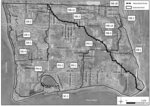

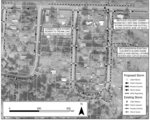
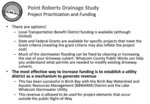
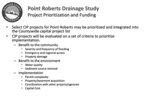
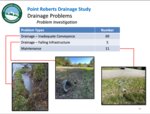
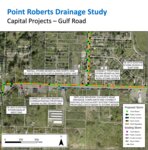
The first phase of a Point Roberts drainage study has now been completed and a pretty picture it isn’t. Whatcom County Public Works staffers presented their initial overview at the Point Roberts Community Advisory Committee meeting on September 19 at the Gulf Road community center.
Project manager Eric Vavra began by describing the purpose of the study, which was to review existing information, characterize the watershed, identify surface water problems, evaluate the problems and organize by type and to rank and prioritize capital projects. Vavra said the Point was comprised of five separate subwatersheds, roughly corresponding to the four corners of the Point with the southwestern marina subwatershed extending into the center of the Point and the north- and south-east watersheds separated by an eastern bluff one extending roughly from Elizabeth Drive to Lily Point.
A total of 89 distinct drainage problems were identified of which 69 resulted from inadequate conveyance (or limited ability to drain water), five from damaged infrastructure and 11 from inadequate maintenance. The single biggest driver of drainage problems is impervious surfaces, according to county consultant Alex Buescher from Tetra Tech. These include roadways and driveways and rooftops, among others. The more impervious surfaces in a given area will result in more runoff as opposed to being absorbed by land surfaces. Buescher said hydraulic modeling had identified 20 distinct flooding locations on the Point or regional areas where flooding occurs.
Vavra pointed out that keeping driveway culverts cleaned out is a homeowner responsibility as is replacing those culverts if they are undersized or damaged. Ditches, on the other hand, are a county responsibility and the county is still working on the backlog created when county work crews were unable to come to the Point during the pandemic.
The study identified 39 problems that would be considered capital projects. “Those 39 capital projects turned into 16 total projects meaning many of these projects would solve more than one problem,” said Vavra, adding due to time constraints, he would only describe three of them. Diane Circle off of Roosevelt Drive in Maple Beach would be the most involved problem with an estimated cost of $3 million to fix. It is a very flat area downstream of higher land, has multiple driveway culverts and the downstream end is higher than the upstream end. It would require an underground stormwater sewer system as well as cultural and archaeological surveying and approval.
Over the road flooding on Johnson Road and Monte Drive “is a lot simpler to solve,” said Vavra. Currently, the ditch on the south side of Johnson is two feet deeper than the ditch on the other side of the road which “is supposed to pick up the flow in the ditch and take it north where it will flown into Maple Beach and become someone else’s problem.” The cure is replace the downhill culvert with a deeper one and regrade the uphill ditch. Vavra estimated that project would cost about $450,000 to remedy.
Gulf Road flooding could be solved by extending the stormwater sewer system that was constructed in the 1980s to the west of Julius Drive and extend to it Tyee Drive. That would comprise just one of connected projects and that segment alone would cost upwards of $300,000.
“I do want to be clear that tonight you got the technical experts. You didn’t get the people that are holding the purse strings,” Vavra pointed out. Point Roberts projects would have to compete with other projects in the rest of the county and priorities would be set based on severity and frequency of the problem, the size of the affected population, impact on the environment, and funding sources.
Vavra predicted the final drainage management report would be ready early in the new year at which time they would return to the Point for a return presentation.
Comments
No comments on this item Please log in to comment by clicking here